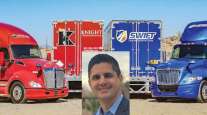Turnover at the Top: New Presidents Take the Helm at Con-way, ABF
By Rip Watson, Senior Reporter
This story appears in the Oct. 10 print edition of Transport Topics.
The less-than-truckload industry is undergoing a changing of the management guard with the recent appointments of new presidents at two of the nation’s largest carriers, ABF Freight System and Con-way Freight.
ABF’s incoming president, Roy Slagle, and Greg Lehmkuhl, his counterpart at Con-way, were named to new posts. The appointments were announced Sept. 21 and 22, just two months after YRC Worldwide Inc. named James Welch its new CEO and subsequently named two other top executives, while abolishing four senior executive posts.
Transport Topics interviewed Slagle, who succeeds the retiring Wes Kemp on Jan. 1, and Lehmkuhl, who is taking over from interim LTL president Doug Stotlar, the corporate CEO, who now is focusing on his regular post.
While Lehmkuhl stressed the continuation of new approaches to managing the company, Slagle emphasized the potential from diversifying ABF’s service portfolio.
Though the emphasis differs, both companies have successfully restored profitability after enduring losses during the recession.
The newly promoted executives’ views, along with comments from Kemp and Stotlar, appear below.
Con-way Freight
Lehmkuhl, who previously was Con-way Freight’s executive vice president of operations, said he sees improving work processes and efficiency as the keys to sustained progress.
The goal, Lehmkuhl said, is to focus on “a lean transformation,” which he defined as a combination of respect for people and a commitment to continuous improvement.
“Nobody knows our business better than front-line drivers and supervisors,” Lehmkuhl said. “We are trying to completely shift to the point where leadership understands they don’t always have the right answer.”
That means, he said, transitioning away from a “command and control” approach in which leadership tells people what to do, to what he described as “supporting front-line employees so they can serve our customers.”
The “lean” approach is focused on four areas: safety improvements, better interaction with customers, damage reduction and use of new technology.
“Lean” includes analytical tools such as operations research programs to maximize network efficiency, technology such as handheld devices to improve freight tracking and equipment such as SafeStack cargo loading to cut down on damage, Lehmkuhl said.
One sign of progress, he said, was a 40% reduction in damage costs over the past 12 months.
Lehmkuhl is taking over at a time when the company’s profitability is being restored. The unit’s operating income more than doubled in 2011’s second quarter from the year before, hitting $39.2 million. That still leaves Con-way Freight far short of its $77.4 million profit in 2008’s second quarter.
The bounce-back accelerated after Stotlar began running the LTL unit in August 2010. After a loss in last year’s first quarter, former President John Labrie left the company.
Stotlar told TT in late September that aligning the efforts of the pricing, sales and operations departments, which were out of whack, was critical to restoring profitability.
Recent gains were achieved, Lehmkuhl noted, even though the company and the United States “have been through a pretty rough economic spell” since Stotlar took over.
“We are very fortunate to have someone with Greg’s background,” Stotlar said. “It was very important that Greg and I saw the world in the same way.”
“We have done a very good job culling the freight network,” Lehmkuhl said. “We have raised prices where we need to. The network is in balance right now.”
Before joining Con-way Freight in 2008, he was vice president at Menlo Worldwide Logistics with responsibility for strategy, pricing, operations and marketing. Prior to arriving at Menlo, he was an executive at Delphi Automotive Systems and Penske Logistics.
Describing Lehmkuhl as an “inspirational leader,” Stotlar said that over the past year, the unit’s new president more and more became the “face” of Freight, doing monthly conference calls with service center managers that now include managers from the sales department as well.
Stotlar said one goal was to revive the atmosphere that was in place during the early years of Con-way’s operation, when the front-line workers had a key role in achieving success.
He’d also like to restore the profits that reflected an operating ratio barely above 90.
“I see nothing preventing us getting back to historical margins,” Stotlar said, without putting a timetable on further improvement. “We are going to be able to wring efficiencies out of our company. It is all about prioritizing. We have lean projects lined up for five years. We have a clear line of sight to be a leader in this industry again and be best in class in the LTL space.”
ABF Freight
Slagle told TT he intends to further widen the focus of Arkansas Best Corp.’s largest subsidiary.
“We have to adapt to a marketplace that has changed and offer a broader portfolio of services — primarily from Asia,” he told TT. “ABF will be a broader resource for supply chain and logistics customers.”
Most recently, ABF diversified by opening new offices in 11 Asian countries. ABF also offers warehousing, final-mile delivery, time critical, household goods and other services.
“We are doing some significant market research,” said Slagle. “There is a list of initiatives we are examining. The things we are focusing on are in the general field of logistics and transportation. We are not going to go far afield.”
Slagle also stressed stability — and gratitude.
“There’s not a need for radical change,” Slagle said. “One of the great things about following Wes is that there aren’t things that need dramatic change.”
“On behalf of the people at ABF, we owe a debt of gratitude to Wes Kemp,” he added.
Kemp took over as ABF’s president in August, 2008, just before the U.S. financial crisis triggered the recession.
“The last three years haven’t been a fun time,” said Kemp. “We have turned the corner. We are back in the black. As long as the economy doesn’t have a big drop and competitors don’t do anything foolish in the pricing department, this is going to be a very lucrative business.”
“While the economy hasn’t recovered robustly, it has recovered to some degree,” he continued. “I see things stabilizing. We are not seeing the desperation raising its ugly head.”
ABF’s profitability returned in the second quarter with operating income of $8.2 million and an operating ratio of 98.2. Those marks followed 10 consecutive quarters of losses.
Kemp, who joined ABF 42 years ago, termed the recession “the most challenging period of my career” because it forced painful steps such as laying off 3,000 workers.
The recession and recovery comprised the stiffest test the company has faced since the late 1990s after the acquisition of financially troubled Carolina Freight.
ABF began to turn around its fortunes in the second quarter of 2010, Kemp said, when pricing stabilized and freight volume began to improve.
ABF’s transition over the next several months began in late September, as the two executives met with department heads.
“One of the great things is that we have three months to work together to assure a smooth transition,” said Slagle, who described his management style as “practical.”
“I’ll try to look ahead at future needs and prepare to modify the company’s offerings to what customers need,” he said.
One matter that lies ahead for Slagle is labor-related.
ABF sued the Teamsters union and YRC after failing to obtain a 15% wage cut the union granted to YRC. The case is pending in U.S. District Court.
ABF’s action was uncharacteristic, Kemp said.
“Our history is not one of suing people,” he observed. “It was a last resort. It was something we had to do.”
Slagle maintained that despite the suit, “The relationship [with the Teamsters] still remains pretty positive and businesslike.”
Slagle also faces the challenge of restoring historical operating ratios that were in the low 90s in the 2005-2007 period.
“To properly recapitalize the company and continue to generate cash and fund new endeavors that is the range we need to get to [a 91-93 operating ratio],” Kemp said. “As the economy creates opportunities, that will bring opportunities for us.”




